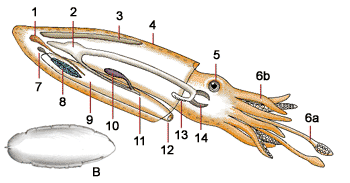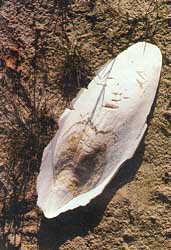Cuttlebone: What Is It?
Cuttlebone is the calcareous internal shell of a cuttlefish. A cuttlefish is a cephalopod, related to squids and octopi. They have eight arms and two tentacles. They eject a black ink-like fluid when in danger. In fact, the outer, hard shell is often stained with this black ink. They are found in oceans all over the world.

Body plan of a cuttlefish
1: gonad; 2: stomach; 3: shell (cuttlebone); 4: mantle; 5: eye; 6a: long tentacles; 6b: short tentacles; 7: heart; 8: kidney; 9: mantle cavity (pallial cavity); 10: ink gland; 11: anus; 12: funnel (sipho); 13: radula; 14: beak; B: internal shell (cuttlebone).
Importance To Diet
Cuttlefish is an important dietary item in many countries. Most come from Asia, especially Taiwan and the Philippines. Some Philippine cuttlebones are more than 16 inches long. Cuttlebone is the only bone in the cuttlefish, and it is discarded when the fish are cleaned in preparation for eating. These bones are washed and sun bleached for export. Cuttlebone is not only used as a dietary supplement for bird keepers. I sell some of the larger pieces to jewelers, who use it for casting gold and silver jewelry. Apparently, they carve a pattern into it and pour in the molten metal. Grinding it into a fine powder to use as an abrasive polishing compound is another use for it.
What good is cuttlebone to a bird? Well, it is not for sharpening the beak. It's amazing how many pet owners think this is its purpose. Cuttlebone is provided to birds as a source of calcium and other necessary minerals. It is especially important to breeding hens.
Components Of Cuttlebone
The major component of cuttlebone is calcium carbonate (85 percent). This is also the major component in eggshells. The next major component is organic material (8.9 percent), mainly carbohydrate material. The nitrogen content of 8,300 mg/kg indicates that approximately 20 percent of the organic material is proteinaceous. The 1.4 percent acid-insoluble material is silicate (sand). The remaining elements are all trace elements. No specified toxic heavy metals were detected.

Do Birds Need Cuttlebone?
The question remains, does my bird need cuttlebone? The answer is yes. Your bird, especially an egg-laying hen, needs calcium. Cuttlebone provides a natural, inexpensive source of calcium carbonate as well as other trace minerals. Most man-made mineral blocks are made from plaster of Paris. They also contain whatever the manufacturer decided to add, whether it be food coloring or seed. On the other hand, cuttlebone is a natural product, containing no toxins or contaminants.
All birds need calcium, and cuttlebone is as good a source as any. Most of the parrots will willingly chew up a cuttlebone. Others, such as mynahs, toucans, etc., will not eat cuttlebone as it naturally occurs. In feeding these softbill species, it is just a matter of scraping cuttlebone into their soft-food mix.
| An Analysis of a Sample of Cuttlebone | |
| Acid insolubles | 1.4% |
| Moisture content | 2.3% |
| Organic content | 8.9% |
| Calcium | 85% Calcium Carbonate |
| Magnesium | 0.42 % Magnesium Carbonate |
| Potassium | 63 mg/kg |
| Total Kjeldahl Nitrogen | 8,300 mg/kg |
| Total Phosphate | 20 mg/kg |
| Heavy Metals (mg/kg = parts per million) | |
| Zinc | 167 |
| Iron | 101 |
| Cobalt | 19 |
| Copper | 11 |
| Manganese | 8 |